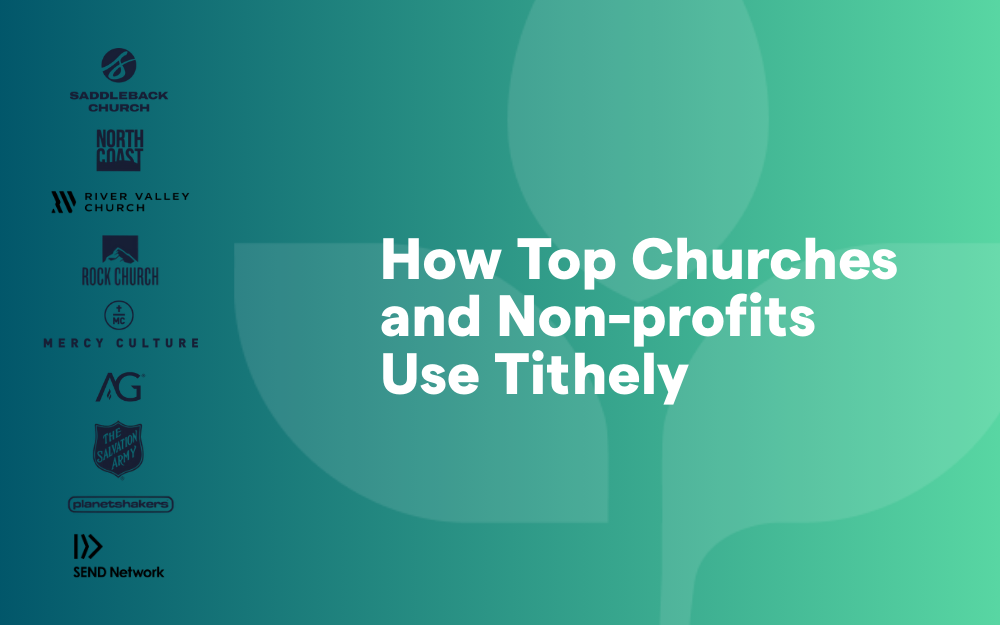4 Helpful Insights Our Year-End Church Giving Survey Provided
Discover the year-end giving insights we learned after surveying more than 5,500 church leaders.

The end of 2020 comes as a relief for most of us.
This has been an interesting year to say the least, and many of us will be thankful when it’s in our rearview mirror completely.
However, don’t be too quick to write off the year just yet, because there is still an important tradition to carry out before we can welcome the new year.
No, I’m not talking about Black Friday or listening to Christmas music too early. I’m talking about year-end giving. That’s right—December is the month when most charitable giving takes place, including church donations.
To help us better understand how year-end giving would look on a year when everything else seems to be different, we conducted a survey of more than 5,500 church leaders. These are the four most insightful takeaways about end of year giving from their responses:
1. Church leaders are still optimistic about year-end giving in 2020
About 30% of all charitable giving happens during the month of December, and a whopping 11% on New Year's Eve alone. In other words, year-end giving is significant for church finances, but how will the on-going pandemic impact how people donate at the end of 2020?
The church leaders we polled are still optimistic about their year-end fundraising, despite all of the turbulence during the year.
About half of churches we surveyed expect their year-end contributions to be roughly the same as 2019. A third are anticipating a slight drop off compared to last year, while 17% of churches actually foresee an increase in December donations.
.jpeg)
For total yearly giving, most churches are still optimistic about matching (18%) or even exceeding (30%) 2019 income. So while COVID-19 has greatly impacted much of what we do, it has not disrupted 2020 giving nearly as much as it could have.
2. COVID-19 has impacted 2020 giving, but not too dramatically
As you might expect, the global pandemic of 2020 has impacted most all aspects of church life, including tithing. However, the financial change has not been nearly as drastic as the shift in most other areas.
Thankfully, only about a third of churches we polled (36%) saw a decrease in giving since March 2020. 46 percent reported that giving stayed about the same compared to past year, and 16% of churches have actually seen an increase in contributions during 2020.
.jpeg)
Even for many congregations with a decrease, it was mostly gradual. About 40% of churches said their giving decrease was less than 15%, and only 5% of churches saw a dip of over 20%.
While 2020 has been wild and unpredictable, the area of church giving has stayed relatively steady. A particularly generous year-end giving season could even help to balance out the decreases for some churches.
3. The pandemic pushed more churches to adopt online giving
One reason why this pandemic has not been more financially disrupting for congregations is technology. The ability to accept donations through a variety of sources, especially online and mobile, means churches have not had to exclusively rely on in-person services.
Over half of our survey respondents (52%) were already using an online giving solution prior to 2020. However, 20% did not already have an online giving option before COVID-19 forced them to adapt. Another 25% of churches had an online giving platform, but were not actively using it until they were forced to.
.jpeg)
Although more churches are adopting new technologies, the numbers show there is still a good deal of growth needing to happen with online giving. Most of the churches (67%) reported less than half of their giving came from online platforms. The most common source of church donations (49%) still being cash or check.
.jpeg)
Eventually, churches will be able to resume in-person services and events without the limitations of social distancing. Even at that point, online and mobile giving will still be a great way to engage with church members. It only makes sense to invest the time and energy into figuring them out now.
4. Year-end giving impacts church operations
As different as 2020 has been, some things have not changed. The importance of year-end giving is one of those things. Especially because these funds raised will have an influence on how churches operate entering into 2021.
One of the reasons why giving has not dropped off as dramatically as it could have is because church leaders have been just as intentional when talking to their congregations about the importance of giving. Most churches (61%) have talked about giving as frequently as before, with about equal amounts discussing it more (22%) or less (15%).
.jpeg)
The funds raised during the end of 2020 will likely impact church budgets moving forward. Thankfully, most churches haven’t had to drastically alter their spending on staff-related or unrelated activities. Even those that did primarily saw a reduction of less than 20%.
Over to you
Continue to speak transparently with your congregation about why it is important to give, and how it impacts your church’s activities. And if you’re looking for more ways to boost the year-end giving at your church, read this blog post for our tips and tricks.
Sign Up for Product Updates
The end of 2020 comes as a relief for most of us.
This has been an interesting year to say the least, and many of us will be thankful when it’s in our rearview mirror completely.
However, don’t be too quick to write off the year just yet, because there is still an important tradition to carry out before we can welcome the new year.
No, I’m not talking about Black Friday or listening to Christmas music too early. I’m talking about year-end giving. That’s right—December is the month when most charitable giving takes place, including church donations.
To help us better understand how year-end giving would look on a year when everything else seems to be different, we conducted a survey of more than 5,500 church leaders. These are the four most insightful takeaways about end of year giving from their responses:
1. Church leaders are still optimistic about year-end giving in 2020
About 30% of all charitable giving happens during the month of December, and a whopping 11% on New Year's Eve alone. In other words, year-end giving is significant for church finances, but how will the on-going pandemic impact how people donate at the end of 2020?
The church leaders we polled are still optimistic about their year-end fundraising, despite all of the turbulence during the year.
About half of churches we surveyed expect their year-end contributions to be roughly the same as 2019. A third are anticipating a slight drop off compared to last year, while 17% of churches actually foresee an increase in December donations.
.jpeg)
For total yearly giving, most churches are still optimistic about matching (18%) or even exceeding (30%) 2019 income. So while COVID-19 has greatly impacted much of what we do, it has not disrupted 2020 giving nearly as much as it could have.
2. COVID-19 has impacted 2020 giving, but not too dramatically
As you might expect, the global pandemic of 2020 has impacted most all aspects of church life, including tithing. However, the financial change has not been nearly as drastic as the shift in most other areas.
Thankfully, only about a third of churches we polled (36%) saw a decrease in giving since March 2020. 46 percent reported that giving stayed about the same compared to past year, and 16% of churches have actually seen an increase in contributions during 2020.
.jpeg)
Even for many congregations with a decrease, it was mostly gradual. About 40% of churches said their giving decrease was less than 15%, and only 5% of churches saw a dip of over 20%.
While 2020 has been wild and unpredictable, the area of church giving has stayed relatively steady. A particularly generous year-end giving season could even help to balance out the decreases for some churches.
3. The pandemic pushed more churches to adopt online giving
One reason why this pandemic has not been more financially disrupting for congregations is technology. The ability to accept donations through a variety of sources, especially online and mobile, means churches have not had to exclusively rely on in-person services.
Over half of our survey respondents (52%) were already using an online giving solution prior to 2020. However, 20% did not already have an online giving option before COVID-19 forced them to adapt. Another 25% of churches had an online giving platform, but were not actively using it until they were forced to.
.jpeg)
Although more churches are adopting new technologies, the numbers show there is still a good deal of growth needing to happen with online giving. Most of the churches (67%) reported less than half of their giving came from online platforms. The most common source of church donations (49%) still being cash or check.
.jpeg)
Eventually, churches will be able to resume in-person services and events without the limitations of social distancing. Even at that point, online and mobile giving will still be a great way to engage with church members. It only makes sense to invest the time and energy into figuring them out now.
4. Year-end giving impacts church operations
As different as 2020 has been, some things have not changed. The importance of year-end giving is one of those things. Especially because these funds raised will have an influence on how churches operate entering into 2021.
One of the reasons why giving has not dropped off as dramatically as it could have is because church leaders have been just as intentional when talking to their congregations about the importance of giving. Most churches (61%) have talked about giving as frequently as before, with about equal amounts discussing it more (22%) or less (15%).
.jpeg)
The funds raised during the end of 2020 will likely impact church budgets moving forward. Thankfully, most churches haven’t had to drastically alter their spending on staff-related or unrelated activities. Even those that did primarily saw a reduction of less than 20%.
Over to you
Continue to speak transparently with your congregation about why it is important to give, and how it impacts your church’s activities. And if you’re looking for more ways to boost the year-end giving at your church, read this blog post for our tips and tricks.
podcast transcript
The end of 2020 comes as a relief for most of us.
This has been an interesting year to say the least, and many of us will be thankful when it’s in our rearview mirror completely.
However, don’t be too quick to write off the year just yet, because there is still an important tradition to carry out before we can welcome the new year.
No, I’m not talking about Black Friday or listening to Christmas music too early. I’m talking about year-end giving. That’s right—December is the month when most charitable giving takes place, including church donations.
To help us better understand how year-end giving would look on a year when everything else seems to be different, we conducted a survey of more than 5,500 church leaders. These are the four most insightful takeaways about end of year giving from their responses:
1. Church leaders are still optimistic about year-end giving in 2020
About 30% of all charitable giving happens during the month of December, and a whopping 11% on New Year's Eve alone. In other words, year-end giving is significant for church finances, but how will the on-going pandemic impact how people donate at the end of 2020?
The church leaders we polled are still optimistic about their year-end fundraising, despite all of the turbulence during the year.
About half of churches we surveyed expect their year-end contributions to be roughly the same as 2019. A third are anticipating a slight drop off compared to last year, while 17% of churches actually foresee an increase in December donations.
.jpeg)
For total yearly giving, most churches are still optimistic about matching (18%) or even exceeding (30%) 2019 income. So while COVID-19 has greatly impacted much of what we do, it has not disrupted 2020 giving nearly as much as it could have.
2. COVID-19 has impacted 2020 giving, but not too dramatically
As you might expect, the global pandemic of 2020 has impacted most all aspects of church life, including tithing. However, the financial change has not been nearly as drastic as the shift in most other areas.
Thankfully, only about a third of churches we polled (36%) saw a decrease in giving since March 2020. 46 percent reported that giving stayed about the same compared to past year, and 16% of churches have actually seen an increase in contributions during 2020.
.jpeg)
Even for many congregations with a decrease, it was mostly gradual. About 40% of churches said their giving decrease was less than 15%, and only 5% of churches saw a dip of over 20%.
While 2020 has been wild and unpredictable, the area of church giving has stayed relatively steady. A particularly generous year-end giving season could even help to balance out the decreases for some churches.
3. The pandemic pushed more churches to adopt online giving
One reason why this pandemic has not been more financially disrupting for congregations is technology. The ability to accept donations through a variety of sources, especially online and mobile, means churches have not had to exclusively rely on in-person services.
Over half of our survey respondents (52%) were already using an online giving solution prior to 2020. However, 20% did not already have an online giving option before COVID-19 forced them to adapt. Another 25% of churches had an online giving platform, but were not actively using it until they were forced to.
.jpeg)
Although more churches are adopting new technologies, the numbers show there is still a good deal of growth needing to happen with online giving. Most of the churches (67%) reported less than half of their giving came from online platforms. The most common source of church donations (49%) still being cash or check.
.jpeg)
Eventually, churches will be able to resume in-person services and events without the limitations of social distancing. Even at that point, online and mobile giving will still be a great way to engage with church members. It only makes sense to invest the time and energy into figuring them out now.
4. Year-end giving impacts church operations
As different as 2020 has been, some things have not changed. The importance of year-end giving is one of those things. Especially because these funds raised will have an influence on how churches operate entering into 2021.
One of the reasons why giving has not dropped off as dramatically as it could have is because church leaders have been just as intentional when talking to their congregations about the importance of giving. Most churches (61%) have talked about giving as frequently as before, with about equal amounts discussing it more (22%) or less (15%).
.jpeg)
The funds raised during the end of 2020 will likely impact church budgets moving forward. Thankfully, most churches haven’t had to drastically alter their spending on staff-related or unrelated activities. Even those that did primarily saw a reduction of less than 20%.
Over to you
Continue to speak transparently with your congregation about why it is important to give, and how it impacts your church’s activities. And if you’re looking for more ways to boost the year-end giving at your church, read this blog post for our tips and tricks.
VIDEO transcript
The end of 2020 comes as a relief for most of us.
This has been an interesting year to say the least, and many of us will be thankful when it’s in our rearview mirror completely.
However, don’t be too quick to write off the year just yet, because there is still an important tradition to carry out before we can welcome the new year.
No, I’m not talking about Black Friday or listening to Christmas music too early. I’m talking about year-end giving. That’s right—December is the month when most charitable giving takes place, including church donations.
To help us better understand how year-end giving would look on a year when everything else seems to be different, we conducted a survey of more than 5,500 church leaders. These are the four most insightful takeaways about end of year giving from their responses:
1. Church leaders are still optimistic about year-end giving in 2020
About 30% of all charitable giving happens during the month of December, and a whopping 11% on New Year's Eve alone. In other words, year-end giving is significant for church finances, but how will the on-going pandemic impact how people donate at the end of 2020?
The church leaders we polled are still optimistic about their year-end fundraising, despite all of the turbulence during the year.
About half of churches we surveyed expect their year-end contributions to be roughly the same as 2019. A third are anticipating a slight drop off compared to last year, while 17% of churches actually foresee an increase in December donations.
.jpeg)
For total yearly giving, most churches are still optimistic about matching (18%) or even exceeding (30%) 2019 income. So while COVID-19 has greatly impacted much of what we do, it has not disrupted 2020 giving nearly as much as it could have.
2. COVID-19 has impacted 2020 giving, but not too dramatically
As you might expect, the global pandemic of 2020 has impacted most all aspects of church life, including tithing. However, the financial change has not been nearly as drastic as the shift in most other areas.
Thankfully, only about a third of churches we polled (36%) saw a decrease in giving since March 2020. 46 percent reported that giving stayed about the same compared to past year, and 16% of churches have actually seen an increase in contributions during 2020.
.jpeg)
Even for many congregations with a decrease, it was mostly gradual. About 40% of churches said their giving decrease was less than 15%, and only 5% of churches saw a dip of over 20%.
While 2020 has been wild and unpredictable, the area of church giving has stayed relatively steady. A particularly generous year-end giving season could even help to balance out the decreases for some churches.
3. The pandemic pushed more churches to adopt online giving
One reason why this pandemic has not been more financially disrupting for congregations is technology. The ability to accept donations through a variety of sources, especially online and mobile, means churches have not had to exclusively rely on in-person services.
Over half of our survey respondents (52%) were already using an online giving solution prior to 2020. However, 20% did not already have an online giving option before COVID-19 forced them to adapt. Another 25% of churches had an online giving platform, but were not actively using it until they were forced to.
.jpeg)
Although more churches are adopting new technologies, the numbers show there is still a good deal of growth needing to happen with online giving. Most of the churches (67%) reported less than half of their giving came from online platforms. The most common source of church donations (49%) still being cash or check.
.jpeg)
Eventually, churches will be able to resume in-person services and events without the limitations of social distancing. Even at that point, online and mobile giving will still be a great way to engage with church members. It only makes sense to invest the time and energy into figuring them out now.
4. Year-end giving impacts church operations
As different as 2020 has been, some things have not changed. The importance of year-end giving is one of those things. Especially because these funds raised will have an influence on how churches operate entering into 2021.
One of the reasons why giving has not dropped off as dramatically as it could have is because church leaders have been just as intentional when talking to their congregations about the importance of giving. Most churches (61%) have talked about giving as frequently as before, with about equal amounts discussing it more (22%) or less (15%).
.jpeg)
The funds raised during the end of 2020 will likely impact church budgets moving forward. Thankfully, most churches haven’t had to drastically alter their spending on staff-related or unrelated activities. Even those that did primarily saw a reduction of less than 20%.
Over to you
Continue to speak transparently with your congregation about why it is important to give, and how it impacts your church’s activities. And if you’re looking for more ways to boost the year-end giving at your church, read this blog post for our tips and tricks.




























